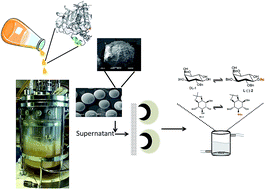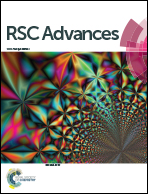Evaluation of the performance of differently immobilized recombinant lipase B from Candida antarctica preparations for the synthesis of pharmacological derivatives in organic media†
Abstract
This paper shows the production of lipase B from Candida antarctica (LIPB) after cloning the gene that encoded it in Pichia pastoris using PGK as a constitutive promoter. The production of the lipase is lower using this strategy but it avoids the use of inducers like methanol. The performance of this enzyme was compared with that of the commercial enzyme (CALB) after immobilization on different supports in different reactions. As supports, we used Accurel 1000, and three core–shell supports (poly(methyl methacrylate) on the core and on the shell – PMMA/PMMA; poly(methyl methacrylate-co-divinylbenzene) on the core and on the shell – PMMA-co-DVB/PMMA-co-DVB; and poly(styrene-co-divinylbenzene) on the core and on the shell – PS-co-DVB/PS-co-DVB). The popular Novozym 435 was also utilized to assess the features of the new biocatalysts. All these supports adsorbed lipases via interfacial activation of the open form of the lipase on the hydrophobic surface of the supports. The studied reactions were esterification of oleic acid and ethanol in a solvent-free medium, resolution of (±)-1,3,5-O-benzyl-myo-inositol via acylation using vinyl acetate in hexane and resolution of (±)-1,2-O-isopropylidene-3,6-di-O-benzyl-myo-inositol via acylation using vinyl acetate (solvent free system). The results varied depending on the employed supports and on the studied reactions, but some general trends may be observed, pointing to better behavior of LIPB compared to CALB. The use of 4 different supports gave more strength to these differences, as it did not depend on a specific difference between a single support/enzyme pair, but it is more general. Thus, LIPB seems to have some advantages compared to the commercial enzyme on all the reactions assayed in this paper. PS-co-DVB/PS-co-DVB-LIPB is in general the most active preparation (even 50% higher activity was observed). Further investigations are in development to determine the structural reasons for these differences.



 Please wait while we load your content...
Please wait while we load your content...